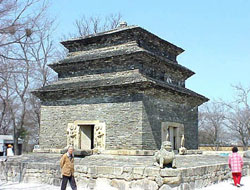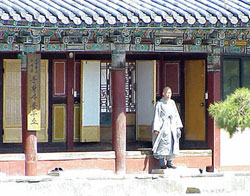
This stone pagoda (designated National Treasure No. 30) was built in 634 during the reign of Queen Seondok (r.632-647). Considering the total number of brick-shaped stones that have been recovered, scholars believe this pagoda must have originally been a seven- or nine-story pagoda. The present three-story pagoda was constructed in 1915 and the remaining stones were piled beside it. Each of the four sides of the first story have a niche with hinged doors.
The figures of Vajradhara (Kumgangyoksa), guardians of the temple, are carved in relief inside the niches. Four stone lions were placed at the cardinal points on the stone platform. A stone sarira case discovered inside the pagoda contained various beads, scissors, gold, silver needles, and a silver bowl with a lid.
The Stone Well of Punhwang-sa temple

This well, which dates from the Shilla period, is round inside and octagonal outside to symbolize the eightfold path and wholeness of Buddhism. The well is called Hogungnyong Pyonojong, meaning "well of the national guardian dragon turned into a fish." According to legend, Shilla had three guardian dragons. One resided in this well, on in the Tongji (East Pond) well, and one in the Ch'ongji (Blue Pond) well at Tongch'on-sa on the slope of Kembak-san. In 795, an envoy from T'ang China turned the dragons into fish, captured them, then took them to China. After his departure, two women asked King Wonsong of Shilla to rescue their dragon husbands. The King found the Chinese envoy, retrieved the dragon-fish, and returned them to their respective homes.



